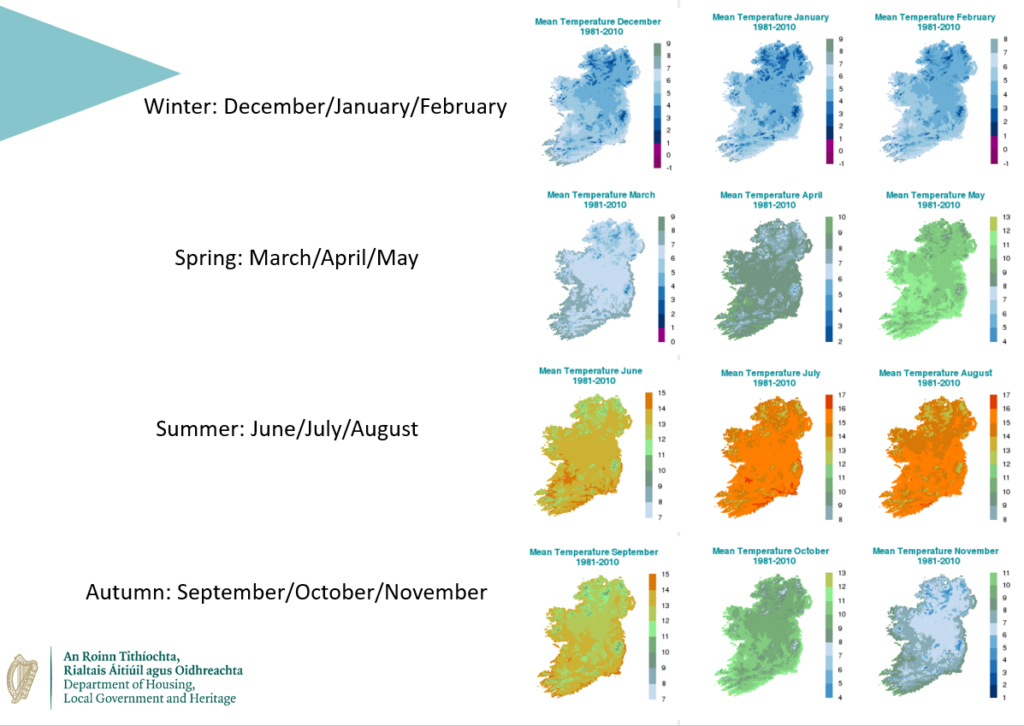In Éirinn, úsáidimid córas ceithre shéasúr an gheimhridh, an earraigh, an tsamhraidh agus an fhómhair, cosúil le go leor tíortha eile sna domhanleithid láir. Is beag éagsúlacht shéasúrach atá i dtíortha in aice leis an meánchiorcal, níl ach dhá shéasúr acu, fliuch nó tirim. Bíonn dhá shéasúr, sé mhí de lá agus d’oíche, i dtíortha in aice leis an mol. Cé go mbíonn sé shéasúr ag roinnt tíortha, lena n-áirítear séasúr monsúin mar shampla. Úsáidimid ‘séasúr stoirme’ in Éirinn freisin, a chomhtharlaíonn le tús an fhómhair mheitéareolaíoch ar an 1 Meán Fómhair gach bliain.
Tá séasúir mheitéareolaíocha ailínithe leis an bhféilire míosúil agus leis na teochtaí chun go mbeidh sé níos fusa monatóireacht a dhéanamh ar staitisticí aimsire agus aeráide ar fud an domhain agus iad a chur i gcomparáid lena chéile. Úsáideann na seirbhísí meitéareolaíocha náisiúnta go léir iad. Mar sin, is cuma cén córas séasúrach a úsáideann gach tír, ó thaobh na meitéareolaíochta agus na haeráide de, labhraímid an teanga chéanna ar fud an domhain trí shéasúir mheitéareolaíocha a úsáid. Tá a fhios againn go léir gurb é an geimhreadh an tréimhse a mbíonn na teochtaí is ísle ann, agus an samhradh an tréimhse a mbíonn na teochtaí is airde ann.
Le séasúir mheitéareolaíocha, táimid uile ag labhairt na ‘teanga’ céanna ar fud an domhain nuair a labhraímid faoi aimsir agus aeráid gach áit.
Cad é an difríocht idir séasúir mheitéareolaíocha agus réalteolaíocha, agus cé acu an téarma ceart le húsáid?
Tá séasúir mheitéareolaíocha bunaithe ar thimthriall bliantúil na dteochtaí, agus sainmhínítear séasúir réalteolaíocha de réir shuíomh an Domhain i gcomparáid leis an nGrian. Tá séasúir thraidisiúnta na hÉireann, Imbolc, Bealtaine, Lughnasa agus Samhain, difriúil arís. Tá siad uile ceart agus úsáidtear iad in Éirinn.
| Dátaí Tosaigh | Traidisiúnta na hÉireann | Réalteolaíoch | Meitéareolaíoch |
|---|---|---|---|
| An tEarrach Embolc |
1st/2nd Feabhra Lá Fhéile Bríde |
An 20th Márta Cónocht an Earraigh |
An 1st Márta |
| Samhradh Bealtaine |
1st Bealtaine | An 20th/21st Meitheamh Grianstad an tSamhraidh |
An 1st Meitheamh |
| An Fómhar Lughnasa |
1st Lúnasa | An 22nd/an 23rd Meán Fómhair Cónocht an Fhómhair |
An 1 Meán Fómhair |
| An Geimhreadh Samhain |
An 31st/an 1st Samhain | An 21st/an 22nd Nollaig Grianstad an Gheimhridh |
An 1st Nollaig |
Tábla 1 Éagsúlacht i séasúir na hÉireann (le dátaí tosaigh nó míonna)
Tá an cleachtas maidir le séasúir a úsáid chun cabhrú le patrúin aimsire, is é sin an aeráid, a mhíniú i bhfeidhm ó 1780 ar a laghad (Cassidy, 1985). Tá séasúir mheitéareolaíocha i bhfad níos simplí agus níos éasca le cuimhneamh ná séasúir réalteolaíocha, mar shampla, toisc gur féidir le dátaí tosaigh agus deiridh séasúr réalteolaíoch athrú gach bliain.
Cad iad na séasúir a d’úsáidfeá dá mbeifeá ag comhlánú meánteochtaí séasúrach?
I Met Éireann, úsáidtear séasúir mheitéareolaíochta chun an bhliain a roinnt ina ceithre chuid chomhfhaid (trí mhí iomlána i ngach ceann acu). Cuidíonn sé seo go mór le staitisticí séasúracha a ríomh agus a sholáthar do tháirgí éagsúla a bhaineann leis an aeráid. Mar shampla, tacaíonn sé le comhoibriú éifeachtach nuair a roinneann Met Éireann staitisticí aeráide agus meitéareolaíocha na hÉireann go hidirnáisiúnta le haghaidh comparáide.
An é an chéad lá de Mhárta nó Cónocht an Earraigh nó Lá Fhéile Bríde tús an Earraigh?
In Éirinn, úsáidtear na trí théarma.
Agus titeann an chéad lá den earrach meitéareolaíoch ar an 1 Márta gach bliain.
Teochtaí séasúracha in Éirinn
Léiríonn geimhrí agus samhraí meitéareolaíocha codarsnachtaí séasúracha láidre, ach meastar gur tréimhsí “idirthréimhseacha” iad an t-earrach agus an fómhar. Léiríonn an chairt teasa thíos na meánteochtaí in aghaidh na huaire do gach séasúr le 30 bliain anuas (1993-2022) ag Aerfort Bhaile Átha Cliath. Mar a thaispeántar, is gnách go mbíonn aimsir níos fionnuaire nó níos fuaire ann le linn an earraigh mheitéareolaíoch ag amanna áirithe den lá i gcomparáid le samhradh meitéareolaíoch.
Bíonn tionchar ag na séasúir ar shioc aeir in Éirinn freisin. De ghnáth bíonn samhraí meitéareolaíocha saor ó shioc aeir, ach bíonn an líon is airde sioc aeir le feiceáil i ngeimhrí meitéareolaíocha, agus buaicphointe acu de ghnáth i mí Eanáir.
Le haeráid atá ag athrú agus teochtaí ag ardú, an athróidh na séasúir in Éirinn freisin?
Tá teochtaí ag Aerfort Bhaile Átha Cliath tar éis ardú 0.5°C ar an meán gach uair an chloig le linn an tsamhraidh agus an gheimhridh mheitéareolaíoch araon, i gcomparáid leis na tréimhsí 30 bliain 1943-1972 agus 1993-2022. Sna tréimhsí céanna, tá méadú 0.2°C ar an meán ar theocht gach uair an chloig san earrach agus san fhómhar.

Fíor 3. Meánteocht Aerfort Bhaile Átha Cliath de réir na huaire (1943-1972) thar na séasúir mheitéareolaíocha
Faoi láthair, in ainneoin na rátaí difriúla méadaithe teochta idir an geimhreadh/an samhradh agus an fómhar/an t-earrach, tá codarsnacht láidir fós idir meánteochtaí séasúracha. Mar sin féin, feiceann roinnt tíortha athruithe séasúracha cheana féin, agus maireann séasúir níos teo níos faide.
Léigh tuilleadh:
Ionad stoirme: www.met.ie/climate/storm-centre
Aeráid Teochta na hÉireann: https://www.met.ie/climate/what-we-measure/temperature
Taifid aeráide náisiúnta: https://www.met.ie/climate/weather-extreme-records
Obair Met Éireann ar an athrú aeráide: https://www.met.ie/climate/climate-change
Tuarascáil PIRAA (an Painéal Idir-Rialtasach ar an Athrú Aeráide): https://www.ipcc.ch/site/assets/uploads/2018/03/SREX-Chap3_FINAL-1.pdf
David C Cassidy (1985). Meteorology in Mannheim: The Palatine Meteorological Society, 1780-1795. https://www.jstor.org/stable/20776952
EPA. 2021. Seasonality and Climate Change: A Review of Observed Evidence in the United States. U.S. Environmental Protection Agency, EPA 430-R-21-002. https://www.epa.gov/climate-indicators/seasonality-and-climate-change
Le haghaidh tuilleadh ceisteanna, déan teagmháil le enquiries@met.ie nó media@met.ie
Rannán na Seirbhísí Aeráide, Met Éireann
An Dr. Sandra Spillane, Clíomeolaí

